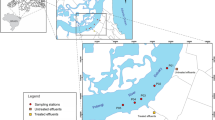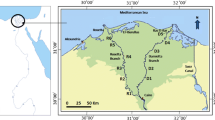Abstract
The water crisis may be solved by utilizing reclaimed water. Three reclaimed water sources have restored the lower sections of the Licun River, forming a landscaped river. In this paper, the river's water quality was monitored for a year, and the ecological concerns were analyzed using luminescent bacteria, chlorella, and zebrafish. The results indicated that although basic water quality indicators like COD and ammonia fluctuated along the river, the classification of water quality was primarily affected by factors such as flow rate and water depth. Under experimental conditions, the toxic inhibitory effect of river water on luminescent bacteria, chlorella, and zebrafish was related to the treatment process of reclaimed water. It was found that the reclaimed water produced by the MBR, along with the UV disinfection process, showed no detectable toxicity. In contrast, the MBBR process, when combined with coagulation, sedimentation, filtration, ozonation, and chlorination, seemed to be the source of this toxicity. Along the river, the results of water quality assessments and ecological risk assessments were different, indicating that both should be conducted to evaluate rivers replenished with reclaimed water.




Similar content being viewed by others
Data availability
The data supporting the findings of this study are available within the article and its supplementary materials.
References
Alcon F, Martínez-Paz JM, Dolores de Miguel M, Zabala JA (2019) Perception welfare assessment of water reuse in competitive categories. Water Supply 19:1525–1532. https://doi.org/10.2166/ws.2019.019
Arias BG, Merayo N, Millan A, Negro C (2021) Reclaimed water use in industrial cooling circuits: Compatibility with TP11 biocides. J Water Process Eng 43:102227. https://doi.org/10.1016/j.jwpe.2021.102227
Badruzzaman M, Anazi JR, Al-Wohaib FA, Al-Malki AA, Jutail F (2022) Municipal reclaimed water as makeup water for cooling systems: Water efficiency, biohazards, and reliability. Water Resour Ind 28:100188. https://doi.org/10.1016/j.wri.2022.100188
Bai L, Bai YJ, Hou Y, Zhang SR, Wang SR, Ding AZ (2023) Ecological water replenishment to the Yongding River, China: effects of different water sources on inorganic ions and organic matter characteristics. Environ Sci Pollut Res 30:39107–39120. https://doi.org/10.1007/s11356-022-25017-x
Ballesteros-Olza M, Blanco-Gutierrez I, Esteve P, Gomez-Ramos A, Bolinches A (2022) Using reclaimed water to cope with water scarcity: an alternative for agricultural irrigation in Spain. Environ Res Lett 17:125002. https://doi.org/10.1088/1748-9326/aca3bb
Bobková S, Baudisová D, Kozisek F, Jeligová H, Pumann P (2023) Quality of Rainwater and Reclaimed Water Used In Buildings and Selection Of Appropriate Indicators. Cent Eur J Public Health 31:155–165. https://doi.org/10.21101/cejph.a7884
Bro R, Smilde AK (2014) Principal component analysis. Anal Methods 9:2812–2831. https://doi.org/10.1039/C3AY41907J
BWA (Bjing Water Authority, China) (2022) 2022 Beijing Water Resources Bulletin. https://swj.beijing.gov.cn/zwgk/szygb/202307/P020230725429321354629.pdf
Canez TT, Guo B, McIntosh JC, Brusseau ML (2021) Perfluoroalkyl and polyfluoroalkyl substances (PFAS) in groundwater at a reclaimed water recharge facility. Sci Total Environ 791:147906. https://doi.org/10.1016/j.scitotenv.2021.147906
Chen W, Lu S, Jiao W, Wang M, Chang AC (2013) Reclaimed water: A safe irrigation water source? Environ Dev 8:74–83. https://doi.org/10.1016/j.envdev.2013.04.003
Directorate-General for Environment (DG ENV, European Commission) (2022) Regulation (EU) 2020/741 on minimum requirements for water reuse. https://environment.ec.europa.eu/publications/minimum-requirements-water-reuse-guidelines_en. Accessed 20 Apr 2024
Gao H, Yang LH, Song XF (2023) Effect of reclaimed water recharge on bacterial community composition and function in the sediment of the Chaobai River, China. J Soils Sediments 23:526–538. https://doi.org/10.1007/s11368-022-03312-x
He W, Kong X, Qin N, He Q, Liu W, Bai Z, Wang Y, Xu F (2019) Combining species sensitivity distribution (SSD) model and thermodynamic index (exergy) for system-level ecological risk assessment of contaminates in aquatic ecosystems. Enviro Int 133:105275. https://doi.org/10.1016/j.envint.2019.105275
Heng B, Zhang R, Wang Z, Zhang Y, Wang Y, Song Z, Liu C, Sun D, Qi F (2021) Occurrence and risk assessment of volatile halogenated disinfection by-products in an urban river supplied by reclaimed wastewater. Ecotoxicol Environ Saf 211:111912. https://doi.org/10.1016/j.ecoenv.2021.111912
Horriche FJ, Benabdallah S (2020) Assessing Aquifer Water Level and Salinity for a Managed Artificial Recharge Site Using Reclaimed Water. Water 12(2):341. https://doi.org/10.3390/w12020341
Kamo M, Hayashi TI, Iwasaki Y (2022) Revisiting assessment factors for species sensitivity distributions as a function of sample size and variation in species sensitivity. Ecotoxicol Environ Saf 246:114170. https://doi.org/10.1016/j.ecoenv.2022.114170
Kesari KK, Soni R, Jamal QMS, Tripathi P, Lal JA, Jha NK, Siddiqui MH, Kumar P, Tripathi V, Ruokolainen J (2021) Wastewater Treatment and Reuse: a Review of its Applications and Health Implications. Water, Air, Soil Pollut 232:208. https://doi.org/10.1007/s11270-021-05154-8
Kim D, Kim H, An YJ (2023) Species sensitivity distributions of micro- and nanoplastics in soil based on particle characteristics. J Hazard Mater 452:131229. https://doi.org/10.1016/j.jhazmat.2023.131229
Li SN, Zhang CF, Li FH, Ren NQ, Ho SH (2023a) Recent advances of algae-bacteria consortia in aquatic remediation. Crit Rev Environ Sci Technol 53:315–339. https://doi.org/10.1080/10643389.2022.2052704
Li YZ, Kim S, Lee SJ, Kim S (2023b) Metabolic effects of diclofenac on the aquatic food chain - (1) H-NMR study of water flea-zebrafish system. Toxicol Res 39(2):307–315. https://doi.org/10.1007/s43188-022-00167-9
Li Z, Sun Z, Zhang L, Zhan N, Lou C, Lian J (2023c) Investigation of water quality and aquatic ecological succession of a newly constructed river replenished by reclaimed water in Beijing. Heliyon 9(6):e17045. https://doi.org/10.1016/j.heliyon.2023.e17045
Lv X, Zhang J, Liang P, Zhang X, Yang K, Huang X (2020) Phytoplankton in an urban river replenished by reclaimed water: Features, influential factors and simulation. Ecol Indic 112:106090. https://doi.org/10.1016/j.ecolind.2020.106090
Ma D, Weir MH, Hull NM (2023) Fluence-based QMRA model for bacterial photorepair and regrowth in drinking water after decentralized UV disinfection. Water Res 231:119612. https://doi.org/10.1016/j.watres.2023.119612
MEE (Ministry of Ecology and Environment, The People’s Republic of China) (2002) Water and wastewater monitoring and analysis method, 4th edn. China Environment Science Press, Beijing
MEE (Ministry of Ecology and Environment, The People’s Republic of China) (2022) Technical guideline for deriving water quality criteria for freshwater organisms (HJ831-2022)
Ongena S, de Walle AV, Mosquera-Romero S, Driesen N, Gutierrez L, Rabaey K (2023) Comparison of MBR and MBBR followed by UV or electrochemical disinfection for decentralized greywater treatment. Water Res 235:119818. https://doi.org/10.1016/j.watres.2023.119818
Parida VK, Saidulu D, Majumder A, Srivastava A, Gupta B, Gupta AK (2021) Emerging contaminants in wastewater: A critical review on occurrence, existing legislations, risk assessment, and sustainable treatment alternatives. J Environ Chem Eng 9:105966. https://doi.org/10.1016/j.jece.2021.105966
Piatka DR, Wild R, Hartmann J, Kaule R, Kaule L, Gilfedder B, Peiffer S, Geist J, Beierkuhnlein C, Barth JAC (2021) Transfer and transformations of oxygen in rivers as catchment reflectors of continental landscapes: A review. Earth-Sci Rev 220:103729. https://doi.org/10.1016/j.earscirev.2021.103729
Rahman TU, Roy H, Islam MR, Tahmid M, Fariha A, Mazumder A, Tasnim N, Pervez MN, Cai YJ, Naddeo V et al (2023) The Advancement in Membrane Bioreactor (MBR) Technology toward Sustainable Industrial Wastewater Management. Membranes 13(2):181. https://doi.org/10.3390/membranes13020181
Ramanan R, Kim B-H, Cho D-H, Oh H-M, Kim H-S (2016) Algae–bacteria interactions: Evolution, ecology and emerging applications. Biotechnol Adv 34:14–29. https://doi.org/10.1016/j.biotechadv.2015.12.003
Rusinol M, Hundesa A, Cardenas-Youngs Y, Fernandez-Bravo A, Perez-Cataluna A, Moreno-Mesonero L, Moreno Y, Calvo M, Alonso JL, Figueras MJ et al (2020) Microbiological contamination of conventional and reclaimed irrigation water: Evaluation and management measures. Sci Total Environ 710:136298. https://doi.org/10.1016/j.scitotenv.2019.136298
Ruth Olubukola Ajoke A, Emmanuel Edet E, Oko Emmanuel G (2021) Application of water quality index for the assessment of water from different sources in Nigeria. In: Iqbal Ahmed M, Summers JK (eds) Promising techniques for wastewater treatment and water quality assessment. IntechOpen. https://doi.org/10.5772/intechopen.98696
Saggioro EM, Chaves FP, Felix LC, Gomes G, Bila DM (2019) Endocrine Disruptor Degradation by UV/Chlorine and the Impact of Their Removal on Estrogenic Activity and Toxicity. Int J Photoenergy 2019:7408763. https://doi.org/10.1155/2019/7408763
Saidulu D, Majumder A, Gupta AK (2021) A systematic review of moving bed biofilm reactor, membrane bioreactor, and moving bed membrane bioreactor for wastewater treatment: Comparison of research trends, removal mechanisms, and performance. J Enviro Chem Eng 9(5):106112. https://doi.org/10.1016/j.jece.2021.106112
Sanchis J, Petrovic M, Farre MJ (2021) Emission of (chlorinated) reclaimed water into a Mediterranean River and its related effects to the dissolved organic matter fingerprint. Sci Total Enviro 760:143881. https://doi.org/10.1016/j.scitotenv.2020.143881
Seqwater (2023) Purified recycled water in South East Queensland. https://www.seqwater.com.au/water-treatment. Accessed 20 Sept 2023
Shi X, Chen Z, Lu Y, Shi Q, Wu Y, Hu H-Y (2021) Significant increase of assimilable organic carbon (AOC) levels in MBR effluents followed by coagulation, ozonation and combined treatments: implications for biostability control of reclaimed water. Front Environ Sci Eng 15:68. https://doi.org/10.1007/s11783-020-1360-8
Thilmany EA, Newton S, Goeringer P, Rosenberg Goldstein RE (2024) Reclaimed Water Use Regulations in the U.S.: Evaluating Changes and Regional Patterns in Patchwork State Policies from 2004–2023. Water 16:334. https://doi.org/10.3390/w16020334
Xu J, Zhao C, Wei D, Du Y (2014) A toxicity-based method for evaluating safety of reclaimed water for environmental reuses. J Environ Sci 26:1961–1969. https://doi.org/10.1016/j.jes.2014.07.008
Yang Z, Wang M, Dong Z, Tan Z, Guo X (2023) Potentially toxic elements contamination, risk and source analysis in sediments of Beiyun River supplied with reclaimed water, China. Ecol Indic 154:110622. https://doi.org/10.1016/j.ecolind.2023.110622
Zabala JA, de Miguel MD, Martinez-Paz JM, Alcon F (2019) Perception welfare assessment of water reuse in competitive categories. Water Supply 19:1525–1532. https://doi.org/10.2166/ws.2019.019
Zaragoza CA, García IF, García IM, Poyato EC, Díaz JAR (2022) Spatio-temporal analysis of nitrogen variations in an irrigation distribution network using reclaimed water for irrigating olive trees. Agric Water Manag 262:107353. https://doi.org/10.1016/j.agwat.2021.107353
Zhang R, Zhang YT, Liu LY, Wang YP, Song ZL, Wang XW, Liu C, Li YN, Meng WD, Zhou Y et al (2020) Occurrence and risk assessment of heavy metals in an urban river supplied by reclaimed wastewater. Water Environ Res 92:1888–1898. https://doi.org/10.1002/wer.1341
Zhao X, Xie E (2023) Reclaimed water influences bacterioplankton and bacteriobenthos communities differently in river networks. Water Res 243:120389. https://doi.org/10.1016/j.watres.2023.120389
Zhao F, Hao Y, Xu Q, Hao Z, Li X, Cheng L, Chen D, Shi X, Xiao Y, Wei P et al (2023) Safety assessment of organic micropollutants in reclaimed water: Chemical analyses, ecological risk assessments, and in vivo endocrine-disrupting studies. Sci Total Environ 884:163865. https://doi.org/10.1016/j.scitotenv.2023.163865
Acknowledgements
The authors thank the Natural Science Foundation of Shandong Province [ZR2021ME059].
Funding
This work was supported by the Natural Science Foundation of Shandong Province [ZR2021ME059].
Author information
Authors and Affiliations
Contributions
Conceptualization, Methodology, Formal analysis, Writing—Review & Editing: [Yanan Cai]; Investigation, Writing—Original Draft: [Yunze Bi]; Investigation, Writing—Original Draft: [Bowen Tian]; Writing—Review & Editing: [Lihua Cheng]; Investigation, Formal analysis: [Shuhui Zhou]; Investigation, Formal analysis: [Quanyong Qi].
Corresponding author
Ethics declarations
Ethical approval
Not applicable.
Consent to participate
All the authors agree to participate.
Consent to publish
All the authors agree to submit the manuscript to Environmental Science and Pollution Research.
Competing interests
The authors declare no competing interests.
Additional information
Responsible Editor: Xianliang Yi
Publisher's Note
Springer Nature remains neutral with regard to jurisdictional claims in published maps and institutional affiliations.
Supplementary Information
Below is the link to the electronic supplementary material.
Rights and permissions
Springer Nature or its licensor (e.g. a society or other partner) holds exclusive rights to this article under a publishing agreement with the author(s) or other rightsholder(s); author self-archiving of the accepted manuscript version of this article is solely governed by the terms of such publishing agreement and applicable law.
About this article
Cite this article
Cai, Y., Bi, Y., Tian, B. et al. Water quality characteristics and ecological risk evaluation of a landscaped river replenished by three reclaimed water sources in Qingdao, China. Environ Sci Pollut Res (2024). https://doi.org/10.1007/s11356-024-33617-y
Received:
Accepted:
Published:
DOI: https://doi.org/10.1007/s11356-024-33617-y




